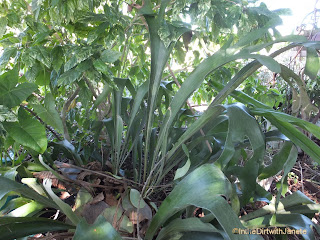
The Staghorn Fern is a member of the Polypodiaceae family. You can see the shape of the leaves look like horns of a deer. Thus the name Staghorn. It's common to the Philippines, SE Asia, Australia, Africa, Madagascar, Indonesia and America. There are several types of Staghorn from "easy to grow" to the "only for the experienced grower". Mine are the easy to grow type. I find them to be a statement piece in any garden. Staghorns do not like to be smothered in dirt. They receive their moisture and nutrients from the air and rain. They will grow on trees, branches and even rocks. The top picture is a Staghorn that I have growing at the base of a tree in my shade garden. The Foliar fronds (fertile fronds) reach 3' high. The Foliar fronds produce brownish fronds called sporangia on the underside. The sporangia hold spores which will produce new plants, when germinated. Spores can be scraped off and put into a plastic bag (for the humidity) and grown into pups. I've never done that so I won't go into telling you how. I wait for new pups to form on the plants. When a pup (small fern) forms, they are easily cut off with a sharp clean knife - making sure to obtain the "root" of the pup. The roots are very hard to see but if you make sure to cut a good 2-3 inches under the pup - you'll most likely get them. Secure some wet peat moss, compost or very rich potting soil to a board or large tree bark or a branch. I use zip ties to secure this and make sure it is very wet so you can keep it all together. Then mount the fern to that - again I use zip ties.Keep it in a shady place for a good 2-3 weeks. Don't use anything sharp - like copper wire- as it will cut into the plant and cause disease. The Basal fronds (sterile) are what attach them selves to wood, peat, trunks and hold the plant in place. It is at the bottom of the plant. Staghorns also do well in baskets - filled with a good peat moss - the longer the moss the better as it holds and distributes moisture over a period of time. Smaller cuts of moss will dry out too fast. Hang the basket sideways for a prettier display of your new plant. Staghorns do not like to be kept real wet. They will rot and die. But they do need a good humid spot to encourage the fern to grow. As the fern grows it will build a 360 degree full fern with many plants growing through and out of the moss. It will take time but it is very rewarding for the patient person.

Above is one growing on a tree trunk
Above is one growing on the ground and shows small pups coming up in the center.
Staghorns grow well, outside, in zones 9-11 but can be grown as house plants in colder climates. Just make it a habit to mist them at least 2 times a week. While they don't like to be soggy - they do need the humidity.....or twice a week - put it in your bathroom and run a hot hot shower to steam the room. Your fern will love you for it and reward you with lush new growth.
Above is a pup that will be cut and mounted. I will do a short video when I do this in early spring.
Another pup that will be cut and mounted.
Staghorns like partial shade and do not like cold temps. This type of Staghorn can stand temps to 30 degrees. It is the Bifurcatum. Fertilizer should be given monthly during the growing season (warm months) at a rate of equal parts - that is 10-10-10 or 20-20-20. They also love banana peels. During non growing months fertilize at least once a month or give it some banana peels.
One disease of the Staghorn is black spots. It is called Rhizoctonia Fungus. If you see this,stop watering the plant and let it dry out completely. Only give it water when it starts to wilt and do so sparingly. If you are in a moist climate - bring the plant to a dry place. Over watering is most likely what caused the fungus to grow. Use of a copper fungicide will stop the spread of the fungus but it won't cure the fungus. Follow the instructions on the container as they each have their own measurements of use. I cut the leaves off that have the black spots. I've only had it twice and both times we had days and days of rain which likely caused it. If you see mealy bugs or scales, use a non oil based insecticide. This will kill the pest. Anytime you bring a new Staghorn into your yard, keep it isolated for a minimum of 2 weeks to make sure there are not pests that will spread to other ferns. I do this with all my plants. Being safe is better then being sorry.
I hope you've enjoyed my "dirt" for today. I'm off to begin the video of building a fairy garden with "foam in a can" I hope you'll check into to see that Friday. It's a 2 days process and today is the build.






The one growing on the tree trunk is absolutely beautiful. I don't understand all the fertilizing stuff yet, but I'm sure you will get into that soon. Looking forward to the fairy garden.
ReplyDeleteWhen you purchase fertilizer there are numbers shows. For the Staghorn Fern, those numbers should be equal parts. On all fertilizers, they represent the same thing. Nitrogen, Phosphorus and Potassium. The Staghorn is most fond of the Potassium but needs the other nutrients too. I hope that helps. Thank you!
ReplyDelete